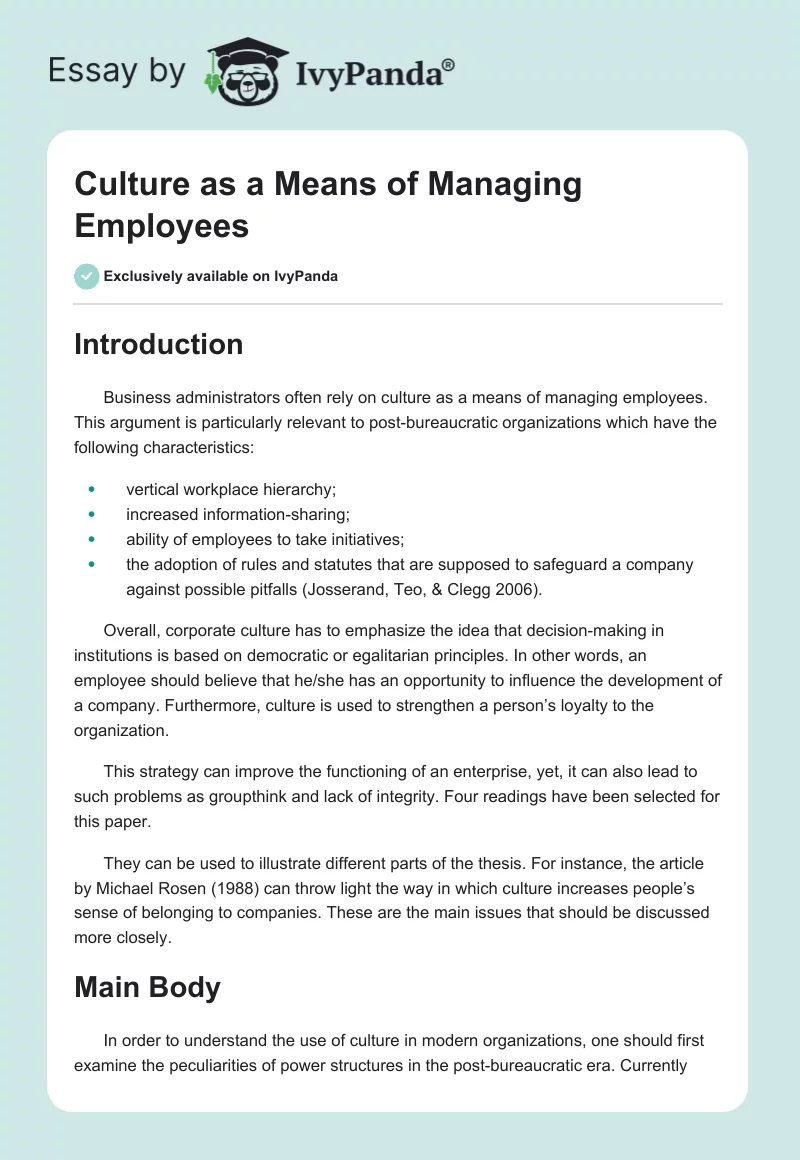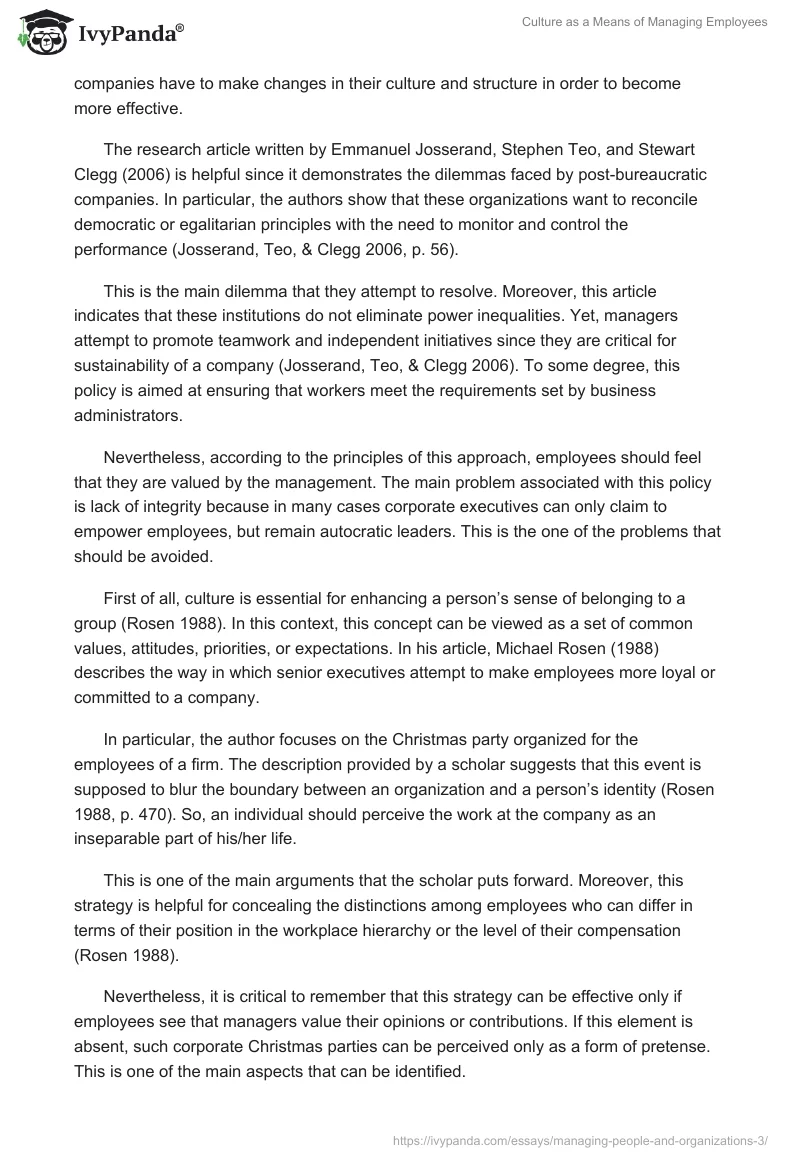Introduction
Business administrators often rely on culture as a means of managing employees. This argument is particularly relevant to post-bureaucratic organizations which have the following characteristics:
- vertical workplace hierarchy;
- increased information-sharing;
- ability of employees to take initiatives;
- the adoption of rules and statutes that are supposed to safeguard a company against possible pitfalls (Josserand, Teo, & Clegg 2006).
Overall, corporate culture has to emphasize the idea that decision-making in institutions is based on democratic or egalitarian principles. In other words, an employee should believe that he/she has an opportunity to influence the development of a company. Furthermore, culture is used to strengthen a person’s loyalty to the organization.
This strategy can improve the functioning of an enterprise, yet, it can also lead to such problems as groupthink and lack of integrity. Four readings have been selected for this paper.
They can be used to illustrate different parts of the thesis. For instance, the article by Michael Rosen (1988) can throw light the way in which culture increases people’s sense of belonging to companies. These are the main issues that should be discussed more closely.
Main Body
In order to understand the use of culture in modern organizations, one should first examine the peculiarities of power structures in the post-bureaucratic era. Currently companies have to make changes in their culture and structure in order to become more effective.
The research article written by Emmanuel Josserand, Stephen Teo, and Stewart Clegg (2006) is helpful since it demonstrates the dilemmas faced by post-bureaucratic companies. In particular, the authors show that these organizations want to reconcile democratic or egalitarian principles with the need to monitor and control the performance (Josserand, Teo, & Clegg 2006, p. 56).
This is the main dilemma that they attempt to resolve. Moreover, this article indicates that these institutions do not eliminate power inequalities. Yet, managers attempt to promote teamwork and independent initiatives since they are critical for sustainability of a company (Josserand, Teo, & Clegg 2006). To some degree, this policy is aimed at ensuring that workers meet the requirements set by business administrators.
Nevertheless, according to the principles of this approach, employees should feel that they are valued by the management. The main problem associated with this policy is lack of integrity because in many cases corporate executives can only claim to empower employees, but remain autocratic leaders. This is the one of the problems that should be avoided.
First of all, culture is essential for enhancing a person’s sense of belonging to a group (Rosen 1988). In this context, this concept can be viewed as a set of common values, attitudes, priorities, or expectations. In his article, Michael Rosen (1988) describes the way in which senior executives attempt to make employees more loyal or committed to a company.
In particular, the author focuses on the Christmas party organized for the employees of a firm. The description provided by a scholar suggests that this event is supposed to blur the boundary between an organization and a person’s identity (Rosen 1988, p. 470). So, an individual should perceive the work at the company as an inseparable part of his/her life.
This is one of the main arguments that the scholar puts forward. Moreover, this strategy is helpful for concealing the distinctions among employees who can differ in terms of their position in the workplace hierarchy or the level of their compensation (Rosen 1988).
Nevertheless, it is critical to remember that this strategy can be effective only if employees see that managers value their opinions or contributions. If this element is absent, such corporate Christmas parties can be perceived only as a form of pretense. This is one of the main aspects that can be identified.
Apart from that, modern culture is important change the workers’ perception of senior executives. In particular, in western countries, people are reluctant to accept autocratic authority of officials or executives. This is why post-bureaucratic companies reject the traditional notion of a boss who has almost absolute authority over the subordinates (Browning 2007, p. 186).
Instead, business administrators emphasize the role of leaders whose power is derived from their expertise or experience. This policy is useful for increasing the motivation of employees. Nevertheless, one should bear in mind that the leadership style in organizations depends upon the challenges that they have to overcome.
In many cases, managers can act in an autocratic way, especially at the time when a company has to take urgent actions (Browning 2007). This transformation is closely discussed by Blair Browning (2007) who examines the choice of leadership styles. This issue is important for understanding the power inequalities in post-bureaucratic institutions.
Overall, employees can accept power inequalities, but they should see that the authority of a leader is derived from his/her expertise or experience, but not from the power to punish others. This issue is important for workers who resist the coercion of the managers. This is the main problem that should be considered.
Nevertheless, the culture of such companies can give rise to several important problems. As it has been said before, these organizations want to lay stress on cohesion, teamwork, and the sense belonging to a group. To a great extent, this policy can indeed bring improvements to companies because teams can work out the most optimal solutions to current problems.
However, there are some risks that should not be overlooked. Much attention should be paid to the dangers of groupthink. This problem is closely discussed by Robert Dimitroff, Lu Schmidt, and Timothy Bond (2005). They examine a situation when employees are reluctant to express opinions that may contradict the views of people who occupy the positions of power. Moreover, they are unwilling to oppose the decisions of the group.
This is one of the reasons why NASA experts disregarded many of the safety rules during the launch of the Challenger (Dimitroff, Schmidt, & Bond 2005, p. 28).
This situation could also be observed in NASA during the Columbia disaster (Dimitroff, Schmidt, & Bond 2005, p. 28). Such difficulties can be faced by various institutions that can be both private and public institutions. This is one of the main risks that should not be overlooked.
Conclusion
This discussion indicates that culture plays an important role in the post-bureaucratic era. In particular, leaders have to rely on it in order to show that employees and managers have common priorities, customs, or values. In this way, they attempt to strengthen the group cohesion in organization.
Although modern corporate culture does not deny the inequalities of power, it has to emphasize the idea that workers also play an important role in the performance of a company. Moreover, this culture implies that the authority of leaders should be derived from their expertise, experience, or personal qualities. These are the main principles of this approach.
However, it is important to mention the corporate culture of post-bureaucratic institutions can lead to groupthink, poor decision-making, and lack of openness.
These are the main risks that should be addressed by leaders. The readings used in this paper have proved to be useful for showing how power is structured and distributed in post-bureaucratic organizations. Additionally, they are helpful for describing the role of culture in these companies. This is why they can be of great value to learners.
References
Browning, B 2007, ‘Leadership in Desperate Times: An Analysis of Endurance: Shackleton’s Incredible Voyage through the Lens of Leadership Theory’, Advances in Developing Human Resources, vol. 9, no. 2, pp. 183-198.
Dimitroff, R, Schmidt, L, & Bond, T 2005, ‘Organizational Behavior and Disaster: A Study of Conflict at NASA’, Project Management Journal, vol. 36, no. 1, pp. 28-38.
Josserand, E, Teo, S, & Clegg, S 2006, ‘From bureaucratic to post-bureaucratic: the difficulties of transition’, Journal of Organizational Change Management, vol. 19, no. 1, pp. 54-64.
Rosen, M 1988, ‘You asked for it: Christmas at the bosses’ expense’, Journal of Management Studies, vol. 25, no. 5, pp. 463-480.


